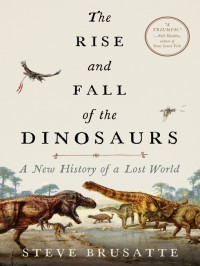

The Rise and Fall of the Dinosaurs
A New History of a Lost World
by Steve Brusatte
In this captivating narrative (enlivened with more than seventy original illustrations and photographs), Steve Brusatte, a young American paleontologist who has emerged as one of the foremost stars of the field—naming fifteen new species and leading groundbreaking scientific studies and fieldwork—masterfully tells the complete, surprising, and new history of the dinosaurs, drawing on cutting-edge science to dramatically bring to life their lost world and illuminate their enigmatic origins, spectacular flourishing, astonishing diversity, cataclysmic extinction, and startling living legacy. Captivating and revelatory, The Rise and Fall of the Dinosaurs is a book for the ages.
Brusatte traces the evolution of dinosaurs from their inauspicious start as small shadow dwellers—themselves the beneficiaries of a mass extinction caused by volcanic eruptions at the beginning of the Triassic period—into the dominant array of species every wide-eyed child memorizes today, T. rex, Triceratops, Brontosaurus, and more. This gifted scientist and writer re-creates the dinosaurs’ peak during the Jurassic and Cretaceous, when thousands of species thrived, and winged and feathered dinosaurs, the prehistoric ancestors of modern birds, emerged. The story continues to the end of the Cretaceous period, when a giant asteroid or comet struck the planet and nearly every dinosaur species (but not all) died out, in the most extraordinary extinction event in earth’s history, one full of lessons for today as we confront a “sixth extinction.”
Brusatte also recalls compelling stories from his globe-trotting expeditions during one of the most exciting eras in dinosaur research—which he calls “a new golden age of discovery”—and offers thrilling accounts of some of the remarkable findings he and his colleagues have made, including primitive human-sized tyrannosaurs; monstrous carnivores even larger than T. rex; and paradigm-shifting feathered raptors from China.
An electrifying scientific history that unearths the dinosaurs’ epic saga, The Rise and Fall of the Dinosaurs will be a definitive and treasured account for decades to come.
This is one of those books that could have been cut down in size readily if we edited out a lot of the details of personal facts. The author tended towards rambling when he starts talking about his own trips to different countries, his own achievements, and his discoveries. He also gives more personal background information about a lot of his colleagues than I really cared to know about, and made general, sweeping declarations about how someone was "the single most important contributor to such and such" which made me feel kind of wary.
He also liked to remind the reader that he's a very, very outstanding paleontologist, and that he's worked with lots of great paleontologists, and that he, alone, has made several discoveries, none of which he actually gives names to. Repeatedly.
There was a lot of repetition of information, bogged down with details as well.
There's a particular part of one of the chapters that kind of stood out to me, because he spends about five or six pages describing the shifting of lands that started breaking apart the super-continent of Pangaea. He describes volcanic activity and lava flow, and how it was what had caused the first mass extinction pre-dinosaur domination. This particular fact was talked about, repeatedly in those few pages. Those first few paragraphs had already told me what I needed to know about the end of the Triassic period. But he went on as if he thought he hadn't already given me enough information to understand the global significance of this event. It got to a point where I forgot that there was another point to this particular chapter.
I'm tempted to count the many times he described Tyrannosaurus Rex's body shape and structure, specifically emphasizing the creature's puny, pathetic arms--I think there might have been at least six instances... within a couple pages. I think I get it. And I figure I already knew this information without it being harked upon. And I feel like maybe we should think about T-Rex's feelings when you keep insulting his itty-bitty arms, because that's just rude. It took him an entire chapter of emphasizing those tiny arms on this enormous apex predator before getting to the point: Why the tyrannosaur still had said small arms anyway?
The rest of the chapter wasn't actually bad, truth be told, if he'd have just stuck with the science. Instead, he tried to be dramatic, opening the chapter with a tacky introduction, seen through the eyes of a triceratops, describing the T-Rex attack of several hadrosaurs. It seemed highly unnecessary. As did many of his other dramatic introductory scenes to a couple other chapters in the book.
Not all of this book is so terrible, however. If it's one thing I could deduce while reading this book, it was that our author is, indeed, knowledgeable and passionate about his career and the study of dinosaurs. There were a few fun new facts I, personally, learned about dinosaurs. And if he was so inclined to go further into some evolutionary studies, I'd be interested. He certainly touched on evolution several times. And you even get a pretty good look at the timeline of the pre-dinosaur era, the rise of the dinosaurs, their evolution over millions of years, and then the final fall of their dominance on Earth.
I didn't need a dramatic telling of the "dinosaur outside his window" to know about the "birds are dinosaurs" tidbit. It's one of the things they teach in a basic science course, y'know. And his exclamation is a bit oversimplified anyway. I did, however, appreciate that he then went into the journey that paleontologists went through to finally make and prove the connection between dinosaurs and birds, though. But his declaration seemed a bit out of tone and unnecessary in light of the fact that, as I already said, this is something you learn in a basic science or biology course about evolution.
And, in a nutshell, evolution is so much more complicated than a simple declaration that "birds are dinosaurs."
This book could have actually been quite informational (and it was, in a way), and it could have been much more interesting to read. But there was too much non-dinosaur story telling involved, which really just managed to make me impatient with the book. It certainly could have used a good edit to cut out unnecessary information.
This book was read for the Flat Book Society as well as 24 Festive Tasks, for the New Year's Eve Book Task.
 |
| The Flat Book Society |
And since we don't really have a graphic for the New Year's Eve door yet, I give you a brief reintroduction to Dino Baby! Rawr!
 |
| I am the true apex predator! I dominate all of your squee's! |

 2
2









